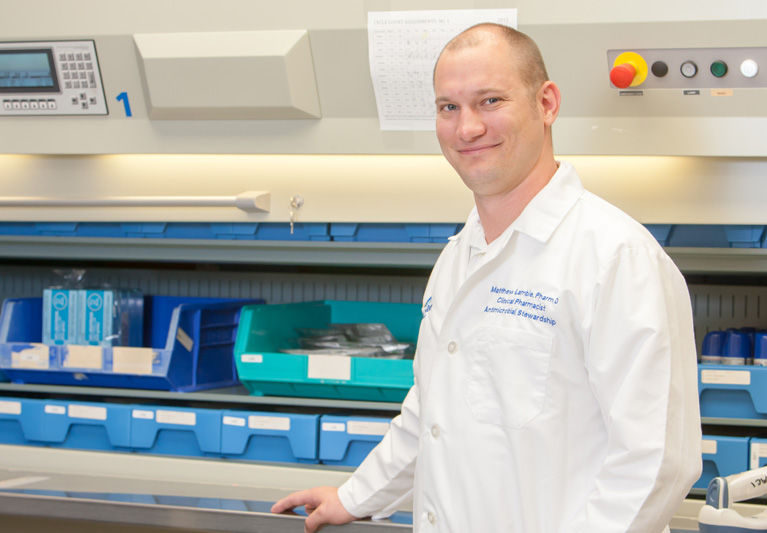
One of the fastest-changing facets of healthcare today has nothing to do with new surgical techniques, advanced robotics or other headline-grabbing “miracles of modern medicine.”
It does have something of a pharmaceutical twist, but it’s not some new generation of drugs.
It’s a new generation of pharmacists.
Patients used to check into hospitals, don a gown, undergo whatever procedure their doctor ordered and leave the hospital without ever seeing – let alone speaking with – one key member of their healthcare team: The hospital pharmacist.
Indian River Medical Center’s Matt Lambie knows the traditional role of the pharmacist is changing and he embraces that change. As the IRMC pharmacy’s clinical manager, Lambie explains, “There’s definitely a big need nationwide to better educate patients about their medications.”
Spurred on by the Affordable Care Act’s stiff financial penalties for hospitals with excessive patient re-admissions, many hospitals are now putting their pharmacists’ clinical training to use by having them work more closely with patients. Explaining the do’s and don’ts of prescription drug use has been shown by the U.S. National Library of Medicine at the National Institutes of Health to bring, “measurable reductions in hospital readmission rates, prescribing errors, drug-related discrepancies, drug administration errors and overall morbidity and mortality rates.”
The NIH continues by saying that expanding the scope of pharmacist-to-patient interactions leads to, “improvements in patient satisfaction and health outcomes (especially) with elderly patients.”
Putting aside those stiff financial penalties for a moment, the University of Florida’s College of Pharmacology says, “Medication errors and preventable adverse events remain a leading cause of death in the United States. It is estimated that approximately 100,000 patients or more die each year in the U.S.” due to mistakes or adverse drug events (ADEs) with prescription drugs.
With at least 100,000 deaths annually from prescription drug problems, there is more at stake here than just Medicare penalties.
As a result, more and more hospital pharmacists are becoming de facto in-patient and out-patient educators, helping to teach individual patients, their family members and caregivers how to maximize the potential benefits and minimize the possible hazards of prescription drugs.
With Vero Beach’s older demographics, Lambie says patients here often have more than one doctor and, “it’s not unusual to see a patient on 16 different medications” at one time. So one thing Lambie and his staff watch out for is “contraindications” or potential drug conflicts. “We see it all the time,” Lambie states.
For example, suppose Doctor A prescribes drug ABC for one condition while Doctor B prescribes drug XYZ for something entirely different. If the two drugs together are likely to cause an ADE, says the 31-year-old with a doctorate of pharmacology from the University of Florida, “We will do whatever we can to make sure the patient doesn’t get those drug until we get clarification from the doctors.”
Considering, as Lambie points out, “IRMC dispenses more than 150,000 medication doses each month,” that’s a tall order.
And, ADEs are not limited to in-hospital situations. They can happen anywhere. As Lambie explains, “maybe (a patient) is getting some prescriptions by mail order or the Veteran’s Administration and maybe getting others at WalMart because they’re cheaper and (still) others at Publix. But not all those systems communicate with one another.”
In other words, if you’re getting 10mg capsules of ABC drug at Publix and 20mg pills of XYZ drug in the mail, the odds are good no one would catch a conflict if there is one.
That’s why Lambie is adamant that people should, “always, always, always” have a full list of their current medications with them, especially when picking up prescription refills. “If the (Publix, CVS or WalMart) pharmacist doesn’t ask, offer it to them anyway,” Lambie advises.
“Pharmacists are the experts in medication therapy, compared to nurses and physicians,” says Jill Haug, director of the American Society of Health-System Pharmacists’ New Practitioners Forum. “They’ve had the most study in medication and are the best-suited to counsel on patients’ medication therapy.”
That’s why Lambie and his 18 fellow pharmacists at IRMC are stepping up their game and stepping out of their cinderblock cubbyholes to engage more directly with patients.
His team, says Lambie, is “carving out time” to meet with patients, family members and caregivers to help them understand their prescription medications more fully. Understanding what the side-effects might be with certain drugs is one important lesson being taught. Knowing what is a normal side-effect and what isn’t normal can be a huge plus for patients as can knowing when they should contact their physician to report anything unexpected or unusual.
And, in an effort to further reduce those hospital re-admission rates, Lambie and his team make follow-up calls to patients once they’ve been discharged. They conduct surveys to make sure any prescription drugs are (still) being administered properly and taken as directed. They also help to answer any pharmaceutical questions those patients may have. These post-discharge phone calls, according to Lambie, average 30 minutes apiece.
Today’s hospital pharmacists may have be trained in infectious diseases, oncology, intravenous medication therapy, neonatal care, nutrition, geriatrics or a host of other fields as well as pharmacology. They also face a far wider set of responsibilities than just plopping pills into a prescription bottle.
In other words, you probably won’t check out of IRMC today without ever having seen – or spoken with – one key member of your healthcare team: A hospital pharmacist.



